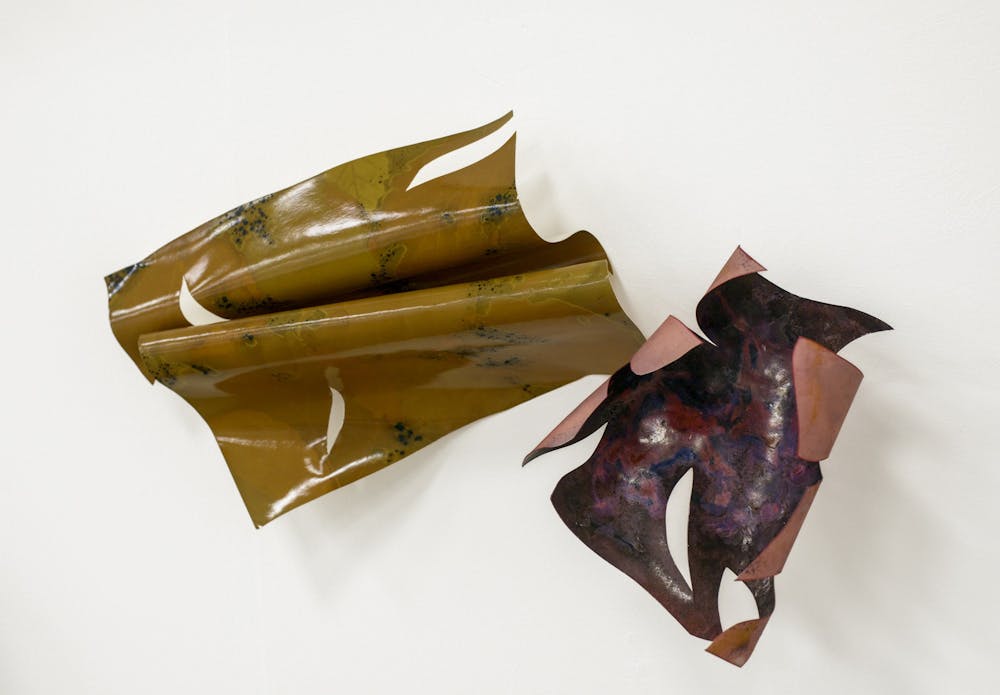On Tuesday, March 21, “Poems From Kay Pacha,” a solo exhibition from University of New Mexico alumnus Rosalba Breazeale, will open at the Strata Gallery in Santa Fe.
The show centers around the idea of homeland; Breazeale pulled from their own identity as a member of the Ashkenazi and Peruvian diasporas, as well as their journey in finding a sense of home in Albuquerque.
“‘Poems from Kay Pacha’ is a collaboration between my body and my plant relatives,” Breazeale said. “Since moving to Albuquerque, I’ve been trying to establish more of a sense of home for myself, so in order to become more rooted in this place, things like getting to know the lands and things like foraging respectfully have been really important for me.”
Breazeale’s work primarily focuses around alternative printing processes. They used plants native to Peru, Albuquerque, and their family home in Limington, Maine as well as items from their personal garden.
The show is an expansion on their thesis exhibition of the same name. Anna Rotty is a UNM master of fine arts candidate who was a cohort of Breazeale’s at UNM and is now a part of the Strata Gallery’s “Emerging Artists Program.” Having seen Breazeale’s work both in the first iteration of “Poems from Kay Pacha” and how the exhibition’s works have changed in the meanwhile, Rotty said that this exhibition will be unique from the original show.
“It’s really time consuming, using analog processes, and it changes over time, so I feel like even if you saw the first iteration, a lot of the work would be different now because it changes as it gets exposed to light over time. So that’s really exciting: to see how some pieces have changed and then what else they’re creating that’s new,” Rotty said.
Breazeale’s work “Symbiotic Relatives” incorporates daylilies from their garden; these seeds were passed down from their grandmother’s garden to their mother’s garden, and then from their mother’s garden to their’s. They said that their work is often centered around their family’s stories and the passing of generational knowledge.
“I think my work is always related to a sense of home. I talk a lot about Peruvian diaspora and Ashkenazi diaspora as a person who wasn’t born in this country and has lived in places that were primarily white; it’s been a long journey to feel like any place is home: I bring my home culture here and use the art to find a way to become more rooted in place,” Breazeale said.
Alongside being able to show new work with the larger gallery space, Breazeale’s use of alternative printing process and unfixed dyes means that even their old works are constantly changing in appearance, according to Rotty.
“The last time that I saw their work altogether installed, it was in a really beautiful but tiny space, and I thought it was amazing in there. But this space is such a different layout, it’s really open and big … so I’m curious to see how they’ll install the work in a much larger space and how (the work) can activate (it) in a different way,” Rotty said.
Rotty said she is most struck by the skillful collaboration with nature and plants that Breazeale is able to achieve in their artwork. Through their artwork, Breazeale hopes to create active participation and connection between many parties: themselves and nature, themselves and the work and the viewer and the work. They said the active, collaborative nature of their experimentation with analog print processing helped move them toward this line of thinking.
Get content from The Daily Lobo delivered to your inbox
“How do I activate this work so that it’s living in space, creating a tangible connection between myself, the viewer and the artwork, and doing so in a way that is empowering the artwork as well as myself as a queer, brown-bodied person. So, not objectifying my work, really moving away from the idea of ownership, because I don’t have total control over what these prints are going to do, and I think there’s something really interesting about having to face that power struggle,” Breazeale said.
Breazeale is a part of the Strata Gallery’s “Emerging Artists Program,” which gives artists opportunities to show their work in solo and group shows as well as mentorship opportunities from established artists. The gallery is particularly interested in showcasing unique voices in art, according to Rotty.
“They are really interested in artists that don’t necessarily make the most sellable, commercial work; they’re really interested in working with artists that work with ephemerality, art that changes each time it’s installed,” Rotty said.
Through this work, Breazeale hopes to convey their sense of passed-down knowledge received from their family as a part of their stories as members of diasporic communities. Though there are certainly aspects of oppression and pure survival in these stories, Breazeale hopes to flip this narrative for their viewers to one of joy and connection.
“I hope it gives (viewers) a moment to really be in their body and connect their mind with their body when they’re receiving the artwork. Ideally it presents some sense of joy, which I also think is very important for this exhibition. I think a lot of the time, artists of color are kind of pushed to perform trauma and oppression, and so this exhibition really fights against that, and instead is about joy. It’s not just about survivance, it’s about thriving and the continued passage of knowledge despite oppression,” Breazeale said.
Zara Roy is the copy chief at the Daily Lobo. She can be reached at copychief@dailylobo.com or on Twitter @zarazzledazzle






